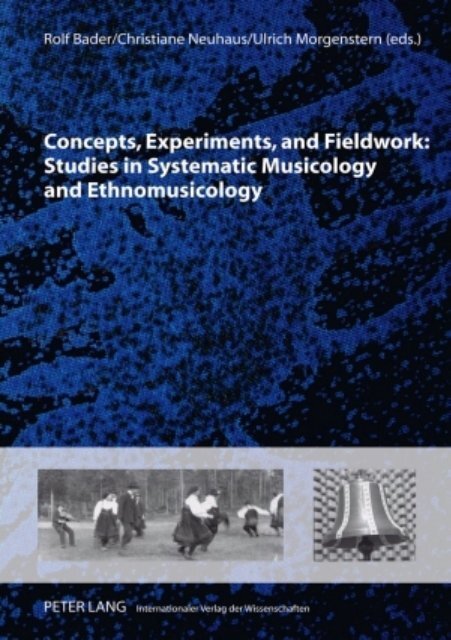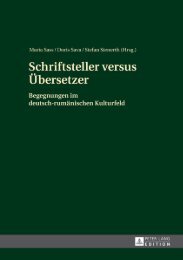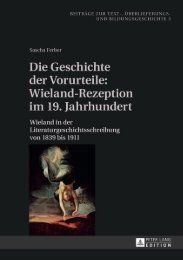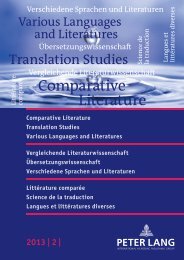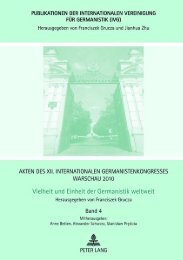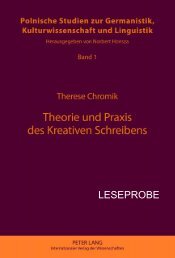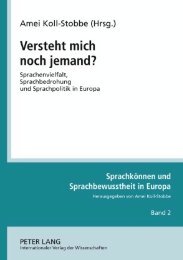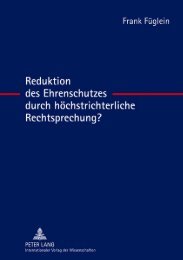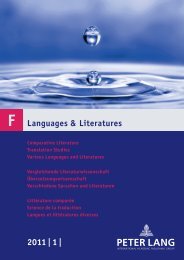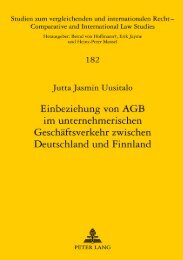Extract (PDF) - Peter Lang
Extract (PDF) - Peter Lang
Extract (PDF) - Peter Lang
You also want an ePaper? Increase the reach of your titles
YUMPU automatically turns print PDFs into web optimized ePapers that Google loves.
Prologue<br />
Rückblick (a song poem by Achim Reichel dedicated to A.S.)<br />
Wenn ein Junge der Sechziger<br />
Auf die Sechzig zugeht,<br />
dann schaut er schon mal zurück.<br />
Das bringt es so mit sich.<br />
Vielleicht fragt er sich dabei, was passiert wäre,<br />
wenn er auf seinem Lebensweg<br />
irgendwann eine andere Abzweigung genommen hätte.<br />
Vielleicht kann er seinem Schicksal aber auch dankbar sein, weil<br />
sich sein Weg als der richtige herausgestellt hat.<br />
Denn dieser führte ihn zunächst geradewegs<br />
in die Arme seiner ersten großen Liebe.<br />
Sie schlüpfte unter seine Haut,<br />
und fuhr ihm durch Mark und Bein.<br />
Sie bescherte ihm Gefühle<br />
Von ungeahnter Dimension.<br />
Das hat ihn tief beeindruckt!<br />
Und sie wurde zu einem festen Bestandteil seines Lebens.<br />
Wer ist dieses geheimnisvolle Wesen?<br />
Es kommt von dort, wo es kein Schauen gibt,<br />
Wo kein Duft ist - keine Hand zum Munde führt.<br />
Es kommt zu Dir, es schlüpft herein<br />
Wohl in Dein Ohr: was kann das sein?<br />
Des Rätsels Lösung:<br />
Es wird die "Musik" sein, und sie ist es auch!<br />
Aber nicht irgendeine, nein, nein.<br />
Es war die richtige zur richtigen Zeit,<br />
sie wurde gemacht von unseren Leuten -<br />
von unserer Generation!<br />
Auch wenn wir von der Welt noch wenig wussten:<br />
wo für die Anderen nur falsche Töne waren,<br />
war für uns die Wahrheit.
Es kam ein Zeitgeist in die Welt,<br />
der unseren Träumen Sinn verlieh<br />
Und eine junge Generation brach auf<br />
und verkündete ihre Botschaft:<br />
Roll over Beethoven - Give peace a chance<br />
Drei Akkorde sagten mehr als tausend Worte<br />
und es geschahen Wunder<br />
Vom Fahrradboten zum Selfmade-Millionär in 36 Monaten<br />
Kleine Plattenfirmen wuchsen zu Konzernen<br />
Hippies wurden in den Adel erhoben<br />
und tapezierten ihre Villen mit Goldenen Schallplatten.<br />
Alle feierten wilde Feste: die Plattenfirmen,<br />
das Radio, das Fernsehen, die Presse,<br />
auf Konzerten, auf Festivals,<br />
vor den Pyramiden und auf dem Dach der Welt.<br />
Es war wie im Märchen - bis das Blatt sich wendete;<br />
Die Geschichte schlug ein neues Blatt auf<br />
Und das geheimnisvolle Wesen "Musik"<br />
Trat ein in den digitalen Seinszustand.<br />
Und wie des Zauberlehrlings Besen von Geister Hand,<br />
teilt es sich fortan in unzählige Kopien seiner selbst;<br />
sehr zum Nachteil für liebgewonnene Geschäftsinteressen<br />
und sehr zum Bedauern für ein liebgewonnenes Ritual, wie:<br />
Wir nehmen vorsichtig eine <strong>Lang</strong>spielplatte aus ihrer Hülle,<br />
legen sie auf den Plattenteller,<br />
setzen erwartungsvoll den Tonarm auf,<br />
um - begleitet von wohligem Knistern -<br />
auf den Einsatz zu warten.<br />
Das war gestern - aber trösten wir uns -<br />
Es gibt sie noch, die echte Musik<br />
Da wo eine Bühne ist und ein Publikum<br />
Oder in fröhlicher Runde, wo drei Akkorde<br />
Mehr sind als tausend Worte.<br />
9
10<br />
Tja, mein lieber Albrecht,<br />
nun reden auch wir<br />
von der guten alten Zeit.<br />
Welch’ Glück für uns:<br />
sie hatte Besseres zu bieten<br />
als die unserer Väter.<br />
Achim Reichel<br />
Achim Reichel, musician, songwriter, composer, producer.<br />
see http://de.wikipedia.org/wiki/Achim_Reichel
Preface<br />
The volume at hand can be considered complementary to a book on systematic and<br />
comparative musicology issued previously that combined essays reflecting theory,<br />
methodology, and disciplinary history with experimental and other empirical studies<br />
as well as with reports of ethnomusicological field work (Schneider [ed.] 2008). A<br />
number of authors who contributed to that volume also have written articles included<br />
in this one. So, in several respects, one could speak of a continuation of efforts.<br />
This volume is organized into four sections plus an appendix. The four sections<br />
contain articles that have been grouped according to main topics. The first relates<br />
to concepts relevant for systematic and cognitive musicology as well as to aspects of<br />
disciplinary history. In his article Marc Leman who lately has outlined a research<br />
programme for embodied music cognition in relation to mediation technology (Leman<br />
2008) proposes a proactive systematic musicology that should take the lead in<br />
planning and organizing research projects that are of social and cultural relevance<br />
rather than to be a moderator of a trans-disciplinary approach to music research.<br />
Jukka Louhivuori who has done field research on music cognition in a cross-cultural<br />
perspective (e.g., Louhivuori 2008), gives an account of how cognitive musicology<br />
was established in Finland, and how it expanded from a science devoted to the<br />
study of the musical mind to an approach that incorporates (almost literally so!)<br />
the body as well as the socio-cultural context in which music making and music listening<br />
take place. Bruno Nettl addresses central issues in ethnomusicology in that<br />
he puts "ten abiding questions" the discipline has been concerned with, such as:<br />
what is music? How did music originate? What is the nature of the musical world?<br />
What are musical idiolects? And also: what is ethnomusicology? Nettl’s reflections<br />
indicate some continuity as well as fundamental changes in ethnomusicological research<br />
paradigms as well as in terminology, canons, and also in self-image. In many<br />
respects, ethnomusicology has become much broader and diversified in its orientations<br />
(and, in turn, less homogeneous in regard of methodology, canons, etc.). Since<br />
there has been a long-standing connection between systematic and comparative musicology,<br />
and also ethnomusicology (see Nettl 2005, Schneider 2006), Oskár Elschek<br />
who has reconstructed the development of modern musicology, and moreover has<br />
proposed a new system of musicological sub-disciplines and research areas (Elschek<br />
1992), in his contribution to this volume has traced some of the developments in<br />
comparative musicology and in ethnomusicology in the 20th century, with a focus<br />
on Middle and Eastern Europe. In countries such as former Czechoslovakia, Poland,<br />
and Hungary intensive research on regional folk music and folk song has been conducted<br />
for decades that led to specific approaches in regard to methodology, ways<br />
of documentation and publication, etc.<br />
In the second section (acoustics and organology), Rolf Bader explores the acoustics<br />
of a Balinese gender plate. In particular in the transient sounds of these metallophones,<br />
certain mode frequencies occur that can be attributed to the unusual<br />
trapezoid cross-section of each plate. The study of the gender with various methods<br />
including Finite Elements and Finite Differences once again demonstrates that<br />
detailed analysis and modelling is necessary to account for the actual properties of<br />
the instrument in question.
12 Bader, Neuhaus, Morgenstern<br />
In his paper on vowel quality in violin sounds, Robert Mores combines objective<br />
acoustical measurement with behavioural experiments. Taking into account findings<br />
on the similarity of vowels and certain musical sounds in regard to spectral<br />
properties, Mores had subjects estimate the similarity of violin tones and vowels<br />
from speech, and he also employed algorithmic machine classification of pairs of<br />
sounds. Among his results is that automatic extraction of vowel quality from violin<br />
sounds can be achieved in a reliable way, and that objective data match subjective<br />
descriptions of violin sounds derived from perceptual analysis.<br />
The acoustics of bells have been a topic of research since long (cf. Rossing 1984).<br />
Scientists of the ranks of L. Euler began to calculate the Eigenmodes and Eigenfrequencies<br />
of vibrating rings, and Lord Rayleigh (1877/1945) already gave a comprehensive<br />
treatment of the inextensional and extensional modes of vibration in solids<br />
such as spherical shells. Though such structures are relatively simple compared to<br />
the complex geometry of western swinging and carillon bells, they share some basic<br />
features (e.g., rotational symmetry around a middle axis), and can therefore serve<br />
as a model to start with. After the pattern of Eigenmodes and Eigenfrequencies<br />
had been established fairly well for western bells, it was time to investigate their<br />
transient behaviour and the actual transfer of energy from the clapper to the bell<br />
as is done in the study of Lau, Bader, Schneider and Wriggers based on a 3D-Finite<br />
Element (FEM) modelling approach (as to this with respect to musical instruments,<br />
see also Bader 2005) as well as on actual measurements obtained from a real bell<br />
that had been cast especially for the experiments and calculations reported here.<br />
Andreas Beurmann, well-known collector of historical keyboard instruments, organologist<br />
and harpsichord player (see Beurmann 2000), gives a personal account of<br />
his motivations in regard to bringing together historical instruments, restoring them<br />
to playability, and to making them available to artists as well as to the music-loving<br />
public. The acquisition of some of the instruments that are part of his large collection<br />
turned out to be quite adventurous affairs that are narrated here in retrospect.<br />
Also in a more personal recollection, Judith Angster (who has published widely on<br />
organ acoustics, in studies some of which were co-written with her husband, see e.g.<br />
Miklós & Angster 2000) and her father, Josef Angster tell about the Angster organ<br />
building workshop that had been established at Pécs (also known as Fünfkirchen in<br />
Hungary). The founder, Josef Angster (grandfather of the present co-author) had<br />
studied with, among others, Aristide Cavaillé-Coll at Paris. In 1867, he opened his<br />
own workshop at Pécs that became famous within a few decades.<br />
Articles in the third section deal with music psychology and neuromusicology as<br />
well as with aspects of music theory and analysis. Daniel Müüllensiefen who had<br />
completed a PhD in Systematic Musicology with a dissertation in music cognition<br />
that investigates memory for melodies as well as melodic similarity (Müllensiefen<br />
2004) is currently working at the Department of Computing, Goldsmiths College,<br />
University of London, UK. He has a special interest in statistics and experimental<br />
design that is also the topic of his article contained in this volume. In particular,<br />
he deals with advanced techniques of multidimensional scaling (MDS), with classification<br />
and regression trees as well as with functional data analysis (FDA) and<br />
Bayesian modelling.
Studies in Systematic Musicology and Ethnomusicology 13<br />
Irène Deliège, a well-known psychologist of music and long-time editor of Musicae<br />
Scientiae (a scholarly journal published by ESCOM, the European Society for the<br />
Cognitive Sciences of Music), in her article proposes a cognitive model for musical<br />
information processing. Her model that accentuates the principle of parallelism is<br />
hierarchical and operates on two planes: processing of information that comes into<br />
the auditory channel of listeners, and storage of information in memory. Claude<br />
Debussy’s Syrinx then serves as an example for Irène Deliège to demonstrate the<br />
operations a cognitive analysis of music would perform according to this model.<br />
The article presented here in English translation appeared in its original French<br />
version in 1987. In order to update her article as well as to provide references<br />
to her subsequent work in cognitive music psychology, Irène Deliège has provided<br />
an Addendum including a list of her more recent publications on issues in music<br />
perception and cognition.<br />
Elvira Brattico and Mari Tervaniemi, two experienced researchers who have conducted<br />
many experiments in cognitive neuromusicology, address the problem of creativity<br />
in musicians. In addition to experimental work that they have discussed in a<br />
book chapter previously (Brattico & Tervaniemi 2006), the present article reports recent<br />
findings and hypotheses (of, in particular A. Dietrich from 2003 and 2004) that<br />
intend to define creativity more closely in regard to brain areas and neurophysiological<br />
processes, respectively. Summing up much of the relevant research, Brattico and<br />
Tervaniemi conclude that "we still do not know whether there are qualitative as well<br />
as quantitative differences in cognitive strategies and neural mechanisms between<br />
highly creative individuals and average subjects". Consequently, more experimental<br />
work will be needed to clarify this matter.<br />
Rolf Inge Godøy, who has been concerned with phenomenology and philosophical<br />
psychology since long, recently has discussed processes of chunking in music (Godøy<br />
2008). As we listen to the quasi-continuous flow of musical sound, we typically apply<br />
segmentation into meaningful units that we may also recode into larger groups. In<br />
the present article, Godøy, inspired by ideas of Edmund Husserl (1928) yet also<br />
by contemporary research on motor control and imagery, discusses ’now-points’ in<br />
music-related movements. Godøy finds the concept of ’now’, and of retention and<br />
protention as outlined by Husserl to be still of relevance in regard to explaining<br />
musical imagery including music-related actions. Timo Fischinger has studied music<br />
education and musicology at Hamburg. After completing his music teacher’s exam,<br />
he turned to music psychology where he carried out experimental research on timing<br />
of musicians, a field that became also the topic of his PhD dissertation (Fischinger<br />
2008). The article contributed to this volume on high-precision timing control first<br />
discusses ideas and findings contained in a broad range of relevant publications,<br />
and then reports essentials of his own approach that is based on a dual-path model<br />
of timing control. This model not only accounts for observations made in tapping<br />
experiments but also for timing behaviour related to musical contexts.<br />
Martin Pfleiderer, an expert in jazz and jazz-related music as well as on rhythm<br />
research (e.g., Pfleiderer 2006), and Klaus Frieler, a physicist and musicologist with<br />
a specialization in formalization and computational modelling (Frieler 2008), present<br />
their current research project labelled "Jazzomat". It is directed at studying jazz<br />
improvisation in regard to musical syntax, in a first step (with an option to include
14 Bader, Neuhaus, Morgenstern<br />
aspects of sound and musical microstructure as related to actual performance later<br />
on). The investigation is to start from a database of musical transcriptions that can<br />
be in a standard symbolic code (CSV, EsAC, MIDI) plus some additional information<br />
necessary for analyses of jazz. The analyses will be carried out with specialdesigned<br />
modules on computer, and the intermediate results can then be processed<br />
further with statistical or other tools. In their article, Pfleiderer and Frieler provide<br />
an example of solos played by saxophonists, Dexter Gordon and Steve Coleman,<br />
respectively, to demonstrate some of their conceptual framework.<br />
Manfred Stahnke, a composer and former student of György Ligeti (1923-2006),<br />
teaches composition at the Hochschule für Musik und Theater, Hamburg. He is the<br />
editor of a book that contains articles devoted to aspects of Ligeti’s work as well<br />
as on works of composers who were related to him in one way or another (Stahnke<br />
2005). Ligeti himself regarded tone systems and tunings other than western 12tone<br />
equal temperament as a possible resource for creating new types of musical<br />
textures that should be used more intensely by contemporary composers. In his<br />
essay, Manfred Stahnke discusses possibilities microtonal systems can offer to the<br />
composer. Pointing to ideas Harry Partch had explored in regard to the formation<br />
of tone systems and scales, he continues with a presentation of music examples from<br />
his own microtonal works.<br />
The fourth section offers articles from ethnomusicology and folk music research<br />
that combine observations from field work with reflections on concepts and methodology.<br />
Hans-Hinrich Thedens, who has done extensive field work in Norway, and has<br />
studied traditional music as well as the musicians who actually play and transmit<br />
such music (e.g., Thedens 2001), in his article considers ’participatory discrepancies’<br />
(a term that seems to have been introduced into ethnomusicology by Charles Keil)<br />
that might possibly exist between fiddle players and dancers with respect to some<br />
traditional Norwegian dance genres. Movements the fiddler executes and the rhythmic<br />
accent patterns he creates from bowing must not always synchronize very well<br />
with the apparent movements of the dancers. Noticing such discrepancies, Thedens<br />
attempts to find features that make up "good rhythm" in traditional fiddle playing.<br />
Ulrich Morgenstern is an ethnomusicologist who has studied the folk music and<br />
its instruments in regions of Northwest Russia. He has published the results of his<br />
fieldwork in the district of Pskov recently in a monograph (Morgenstern 2007). In<br />
the article contributed to this volume, he relates current styles of accordion playing<br />
in the Pskov district to possible older strata and genres of instrumental music.<br />
In particular, Morgenstern believes that the double clarinet trostyanki (or similar<br />
types) that in some Russian districts were in use until World War II (as historical<br />
sources indicate, in some areas quite frequently so), could have influenced the old<br />
style of accordion playing in the Pskov region that was based on two-part textures<br />
(as apparently was the music played on the double clarinet).<br />
Britta Sweers has studied a musical and performance style of English (and in<br />
part also Scottish and Irish) folk music usually labelled ’Electric Folk’ that became<br />
well-known with bands like Fairport Convention, Steeleye Span, and The Pentangle<br />
(cf. Sweers 2005). More recently, she has expanded her research to the Baltic states<br />
of Latvia and Lithuania. In her article, she first describes processes of socio-cultural<br />
transformation that apply to folk music in many countries. She then details such
Studies in Systematic Musicology and Ethnomusicology 15<br />
transformations she has observed when visiting Latvia and Lithuania, respectively.<br />
Finally, she compares phenomena and concepts that result from processes of transformation<br />
(e.g., hybridization) as found in English folk music and ’Electric Folk’,<br />
on the one hand, and in folk music (including ’Electric Folk’) of the Baltics, on the<br />
other.<br />
Martin Boiko is a musicologist based at Riga, Latvia. He has studied the traditional<br />
music of his home country on which he has published in-depth analyses<br />
dealing with specific genres and styles (e.g., Boiko 1996). Some of the fieldwork he<br />
carried out in the Latgalian district of Southeastern Latvia in the 1990s was devoted<br />
to the study of religious music that had been neglected for a long time due<br />
to political circumstances. A genre of prime interest to Boiko is the Office of the<br />
Dead (the Catholic officium defunctorum) as still practiced in Latgalia. His report<br />
based on fieldwork indicates continuity and change, the latter being mostly due to<br />
demographic factors.<br />
Tiago de Oliveira Pinto, who has been a member of the International Institute for<br />
Comparative Music Studies (Berlin), is currently teaching ethnomusicology and comparative<br />
musicology at Weimar, Göttingen, and Hamburg. He conducted fieldwork<br />
in Brazil (cf. Pinto 1999) and in Angola. In his essay, he reflects on ethnography<br />
and addresses problems a researcher might face when working in the field. Such<br />
problems can be technical, however, there are issues that are possibly of greater<br />
concern in regard to concepts and methodology: What is the role of the fieldworker<br />
within a different society and cultural context? How can, and how should he or she<br />
communicate with members of a (music) culture he or she wants to study? What is<br />
the nature, and what is the purpose of (musical) ethnography? Pinto rightly points<br />
to significant changes in anthropological thought that have affected the self-image of<br />
ethnologists and ethnomusicologists alike, and which might call for a reassessment<br />
of concepts and tasks relevant for ethnomusicology.<br />
Jörgen Torp, an expert on Tango and Tango-related music and dance on both sides<br />
of the Atlantic Ocean (Torp 2007), has conducted fieldwork in Argentine. From his<br />
experience as a field-worker that is used to adopt a "culturalist" perspective and a<br />
basically hermeneutic methodology (as has been advocated, perhaps most prominently,<br />
by the anthropologist Clifford Geertz), Torp discusses such crucial issues<br />
as the quest for ’objective’ methods and ’valid’ interpretations in ethnomusicology<br />
and musicology. Pointing to the ’World of Tango’ as a specific cultural sphere that<br />
includes (at least for the Milongueros) a peculiar way of life, he argues that it would<br />
be in vain to expect that such a cultural complex could be investigated with some<br />
standard methodology. Rather, an approach based on personal experience should<br />
be allowed; though it might appear less ’scientific’ in regard to method, such an<br />
approach might be more adequate with respect to the socio-cultural and subjective<br />
phenomena under study.<br />
Finally, we have included, as an appendix, a biographical note of Albrecht Schneider<br />
as well as a bibliography that contains a selection of his scientific publications<br />
from 1971 to the present. Besides doing research in the lab and in the field, Schneider<br />
has been exceptionally active as an academic teacher who, in the Institute of<br />
Musicology of the University of Hamburg, has supervised more than 120 students<br />
writing their M.A. theses on topics in Systematic and Comparative Musicology un-
16 Bader, Neuhaus, Morgenstern<br />
der his guidance. Further, he has been in charge of many graduates who did benefit<br />
from his advice when preparing their Ph.D. dissertations. The present volume is<br />
dedicated to Albrecht Schneider on the occasion of his 60 th birthday.<br />
Hamburg, May 2009<br />
Rolf Bader Christiane Neuhaus Ulrich Morgenstern<br />
(Hamburg) (Leipzig) (Frankfurt)<br />
References<br />
Bader 2005 Rolf Bader. Computational Mechanics of the classical guitar. Springer<br />
Verlag, Berlin (2005)<br />
Beurmann 2000 Andreas Beurmann. Historische Tasteninstrumente. Cembali -<br />
Spinette - Virginale - Clavichorde. München, New York: Prestel (2000)<br />
Boiko 1996 Martin Boiko. Die litauischen Sutartinés. Eine Studie zur baltischen<br />
Volksmusik. PhD. dissertation Univ. Hamburg (1996)<br />
Brattico & Tervaniemi 2006 Elvira Brattico & Mari Tervaniemi. Musical creativity<br />
and the human brain. In I. Deliège and G. Wiggins (eds.). Musical<br />
Creativity. Multidisciplinary Research in Theory and Practice Hove, New<br />
York: Psychology Press, 290-321 (2006)<br />
Elschek 1992 Oskar Elschek. Die Musikforschung der Gegenwart, ihre Systematik,<br />
Theorie und Entwicklung. Vol. 1, 2. Wien-Föhrenau: Stiglmayr (1992)<br />
Fischinger 2008 Timo Fischinger. Timing-Kontrolle bei Musikern und negative<br />
Asynchronie. Eine Untersuchung der zeitlichen Struktur sensomotorischer<br />
Koordination bei Schlagzeugern PhD-dissertation, Univ. Kassel (2008)<br />
Frieler 2008 Klaus Frieler. Mathematik und kognitive Melodieforschung. Grundlagen<br />
für quantitative Modelle. Hamburg: Verlag Dr. Kovac (2008)<br />
Godøy 2008 R.-I. Godøy. Reflections on chunking in music. In A. Schneider (ed.):<br />
Systematic and Comparative Musicology: Concepts, Methods, Findings, 117-<br />
132 (2008)<br />
Husserl 1928 Edmund Husserl. Edmund Husserls Vorlesungen zur Phänomenologie<br />
des inneren Zeitbewußtseins (Lectures, ed. by Martin Heidegger).<br />
Jahrbuch für Philosophie und phänomenologische Forschung 9, Halle:<br />
Niemeyer, 367-496 (1928)<br />
Leman 2008 Marc Leman. Embodied Music cognition and Mediation technology.<br />
Cambridge, MA: MIT Pr. (2008)


